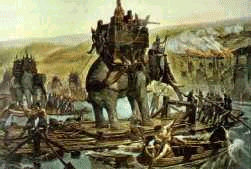
 Hannibal's Plan
Carthage was not going to give up easily. A determined leader of Carthage, Hamilcar Barca directed his attention to Spain where they could get control over the
mineral resources there and create an army from the people there that would
match the Roman legions. His son Hannibal was committed to ruin Rome and created a
military base in Spain.
Hannibal's Plan
Carthage was not going to give up easily. A determined leader of Carthage, Hamilcar Barca directed his attention to Spain where they could get control over the
mineral resources there and create an army from the people there that would
match the Roman legions. His son Hannibal was committed to ruin Rome and created a
military base in Spain.
 Hannibal devised an ingenious plan. His intention was to make a surprise
attack upon Italy herself. He led his new army consisting of 60,000 men, 6,000
horses and 37 war elephants over the River Rhone (with his elephants on rafts), then
across the Pyrenees mountains, then through southern Gaul and they finally
arrived at the Alps after 5 months.
Hannibal devised an ingenious plan. His intention was to make a surprise
attack upon Italy herself. He led his new army consisting of 60,000 men, 6,000
horses and 37 war elephants over the River Rhone (with his elephants on rafts), then
across the Pyrenees mountains, then through southern Gaul and they finally
arrived at the Alps after 5 months.
 Only 1/2 of his army had survived. The Greek historian Polybius described the scene. (see Polybius and Hannibal). Hannibal finally arrived in Italy and went a severe rampage against the
Romans. The Roman historian Livy describes Hannibal's leadership. (see Livy and Hannibal)
Hannibal's Military Genius
Hannibal's military brilliance was unsurpassed and he skillfully maneuvered
his armies along with strategic use of his elephants and he demoralized the
Romans when they came to stop him at Lake Trasimene and Cannae. Hannibal trapped the Roman legions between the hills and the lake at
Trasimene forcing them back into the water where many of them drowned.
The worst defeat for Rome was at Cannae (216 BC) where Hannibal surrounded the
entire Roman army and killed 50,000 men while only losing 6,000 of his own
soldiers. This proved to be Rome's worst military disaster.
Hannibal's manpower was great, but they were not large enough nor did they
have enough equipment to invade the city of Rome or maintain a long siege.
Hannibal remained undefeated for 12 years and his army went anywhere they wanted in
Italy and ravaged the countryside for 4 more years when he was called back to
Africa.
Hannibal is Defeated
Rome could not defeat Hannibal in Italy so she retaliated by conquering Spain
and then attacking Carthage. Under the leadership of Cornelius Scipio Africanus
a Roman army sailed to Africa and attacked Carthage. Hannibal was recalled to
Africa in 203 BC to defend his homeland and he was defeated by Scipio in 202 BC
at Zama Regia, 80 miles southwest of Carthage. This was Hannibal's first defeat. He
escaped to Greece but for Carthage the war was lost.
Only 1/2 of his army had survived. The Greek historian Polybius described the scene. (see Polybius and Hannibal). Hannibal finally arrived in Italy and went a severe rampage against the
Romans. The Roman historian Livy describes Hannibal's leadership. (see Livy and Hannibal)
Hannibal's Military Genius
Hannibal's military brilliance was unsurpassed and he skillfully maneuvered
his armies along with strategic use of his elephants and he demoralized the
Romans when they came to stop him at Lake Trasimene and Cannae. Hannibal trapped the Roman legions between the hills and the lake at
Trasimene forcing them back into the water where many of them drowned.
The worst defeat for Rome was at Cannae (216 BC) where Hannibal surrounded the
entire Roman army and killed 50,000 men while only losing 6,000 of his own
soldiers. This proved to be Rome's worst military disaster.
Hannibal's manpower was great, but they were not large enough nor did they
have enough equipment to invade the city of Rome or maintain a long siege.
Hannibal remained undefeated for 12 years and his army went anywhere they wanted in
Italy and ravaged the countryside for 4 more years when he was called back to
Africa.
Hannibal is Defeated
Rome could not defeat Hannibal in Italy so she retaliated by conquering Spain
and then attacking Carthage. Under the leadership of Cornelius Scipio Africanus
a Roman army sailed to Africa and attacked Carthage. Hannibal was recalled to
Africa in 203 BC to defend his homeland and he was defeated by Scipio in 202 BC
at Zama Regia, 80 miles southwest of Carthage. This was Hannibal's first defeat. He
escaped to Greece but for Carthage the war was lost.
 Scipio Africanus
Carthage surrendered and gave up her fleet and all her overseas territory,
including the Spanish colonies, and paid another large indemnity.
Now Rome was clearly the master of the Mediterranean Sea. (see Hannibal and Scipio)
Scipio Africanus
Carthage surrendered and gave up her fleet and all her overseas territory,
including the Spanish colonies, and paid another large indemnity.
Now Rome was clearly the master of the Mediterranean Sea. (see Hannibal and Scipio)
Read The Bible
- 1599 Geneva Bible (GNV)
- 21st Century King James Version (KJ21)
- American Standard Version (ASV)
- Amplified Bible (AMP)
- Amplified Bible, Classic Edition (AMPC)
- Authorized (King James) Version (AKJV)
- BRG Bible (BRG)
- Christian Standard Bible (CSB)
- Common English Bible (CEB)
- Complete Jewish Bible (CJB)
- Contemporary English Version (CEV)
- Darby Translation (DARBY)
- Disciples’ Literal New Testament (DLNT)
- Douay-Rheims 1899 American Edition (DRA)
- Easy-to-Read Version (ERV)
- English Standard Version (ESV)
- English Standard Version Anglicised (ESVUK)
- Evangelical Heritage Version (EHV)
- Expanded Bible (EXB)
- GOD’S WORD Translation (GW)
- Good News Translation (GNT)
- Holman Christian Standard Bible (HCSB)
- International Children’s Bible (ICB)
- International Standard Version (ISV)
- J.B. Phillips New Testament (PHILLIPS)
- Jubilee Bible 2000 (JUB)
- King James Version (KJV)
- Lexham English Bible (LEB)
- Living Bible (TLB)
- Modern English Version (MEV)
- Mounce Reverse Interlinear New Testament (MOUNCE)
- Names of God Bible (NOG)
- New American Bible (Revised Edition) (NABRE)
- New American Standard Bible (NASB)
- New American Standard Bible 1995 (NASB1995)
- New Catholic Bible (NCB)
- New Century Version (NCV)
- New English Translation (NET)
- New International Reader's Version (NIRV)
- New International Version - UK (NIVUK)
- New International Version (NIV)
- New King James Version (NKJV)
- New Life Version (NLV)
- New Living Translation (NLT)
- New Matthew Bible (NMB)
- New Revised Standard Version (NRSV)
- New Revised Standard Version Catholic Edition (NRSVCE)
- New Revised Standard Version, Anglicised (NRSVA)
- New Revised Standard Version, Anglicised Catholic Edition (NRSVACE)
- New Testament for Everyone (NTE)
- Orthodox Jewish Bible (OJB)
- Revised Geneva Translation (RGT)
- Revised Standard Version (RSV)
- Revised Standard Version Catholic Edition (RSVCE)
- The Message (MSG)
- The Voice (VOICE)
- Tree of Life Version (TLV)
- World English Bible (WEB)
- Worldwide English (New Testament) (WE)
- Wycliffe Bible (WYC)
- Young's Literal Translation (YLT)
Table of Contents
Main Menu
- Ancient Assyrian Social Structure
- Ancient Babylonia
- Ancient Canaan During the Time of Joshua
- Ancient History Timeline
- Ancient Oil Lamps
- Antonia Fortress
- Archaeology of Ancient Assyria
- Assyria and Bible Prophecy
- Augustus Caesar
- Background Bible Study
- Bible
- Biblical Geography
- Fallen Empires - Archaeological Discoveries and the Bible
- First Century Jerusalem
- Glossary of Latin Words
- Herod Agrippa I
- Herod Antipas
- Herod the Great
- Herod's Temple
- High Priest's in New Testament Times
- Jewish Literature in New Testament Times
- Library collection
- Map of David's Kingdom
- Map of the Divided Kingdom - Israel and Judah
- Map of the Ministry of Jesus
- Matthew Henry Bible Commentary
- Messianic Prophecy
- Nero Caesar Emperor
- Online Bible Maps
- Paul's First Missionary Journey
- Paul's Second Missionary Journey
- Paul's Third Missionary Journey
- Pontius Pilate
- Questions About the Ancient World
- Tabernacle of Ancient Israel
- Tax Collectors in New Testament Times
- The Babylonian Captivity
- The Black Obelisk of Shalmaneser
- The Books of the New Testament
- The Court of the Gentiles
- The Court of the Women in the Temple
- The Destruction of Israel
- The Fall of Judah with Map
- The History Of Rome
- The Incredible Bible
- The Jewish Calendar in Ancient Hebrew History
- The Life of Jesus in Chronological Order
- The Life of Jesus in Harmony
- The Names of God
- The New Testament
- The Old Testament
- The Passion of the Christ
- The Pharisees
- The Sacred Year of Israel in New Testament Times
- The Samaritans
- The Scribes
Ancient Questions
- Why Do the Huldah Gates Appear Different in Ancient Replicas and Modern Photos?
- What Is the Origin of the Japanese and Chinese Peoples? A Biblical Perspective
- How did the ancient Greeks and Romans practice medicine and treat illnesses?
- What were the major contributions of ancient Babylon to mathematics and astronomy?
- How did the ancient Persians create and administer their vast empire?
- What were the cultural and artistic achievements of ancient India, particularly during the Gupta Empire?
- How did ancient civilizations like the Incas and Aztecs build their remarkable cities and structures?
- What were the major trade routes and trading practices of the ancient world?
- What was the role of slavery in ancient societies like Rome and Greece?
- How did the ancient Mayans develop their sophisticated calendar system?
Bible Study Questions
- Why Do Christians Celebrate Christmas?
- How Many Chapters Are There in the Bible?
- The Five Key Visions in the New Testament
- The 400-Year Prophecy: Unpacking Genesis 15 and the Journey of a People
- The Authorized (King James) Version (AKJV): Historical Significance, Translation Methodology, and Lasting Impact
- Exploring the English Standard Version (ESV): Its Aspects, Comparisons, Impact on Biblical Studies, and Church Use
- A Detailed Historical Analysis of Language Updates in the KJ21: Comparison with Other Versions
- A Detailed Historical Analysis of the American Standard Version (ASV): Comparison to the King James Version, Influence on Later Translations, and Evaluation of Strengths and Weaknesses
- A Detailed Historical Analysis of Amplifications in the Amplified Bible (AMP) and Its Comparison to Other Bible Translations
- Detailed Historical Analysis of the Amplified Bible Classic Edition (AMPC): Examples of Amplifications and Comparative Analysis with Other Bible Translations
About
Welcome to Free Bible: Unearthing the Past, Illuminating the Present! Step into a world where ancient history and biblical narratives intertwine, inviting you to explore the rich tapestry of human civilization.
Discover the captivating stories of forgotten empires, delve into the customs and cultures of our ancestors, and witness the remarkable findings unearthed by dedicated archaeologists.
Immerse yourself in a treasure trove of knowledge, where the past comes alive and illuminates our understanding of the present.
Join us on this extraordinary journey through time, where curiosity is rewarded and ancient mysteries await your exploration.
Recent posts
-

How Philips Zoom Handpiece Limitations Impact Clinic Profitability — And How to Break the Cycle
For most dental and aesthetic clinics, professional whitening is expected to be one of the highest-margin services. Patients are willing to pay premiu... -

Do Scientists Believe in God? Faith and Science in the 21st Century
For centuries, people have debated whether science and faith can go hand in hand. Some argue that science should rely only on what can be measured and... -

Listening Deeper: Ekaterina Fakhrutdinova on How Soul Care Becomes a New Culture of Care
Author: Susan Perk Date: 24 Sep 2025 When faith is not dogma, but dialogue. And when psychology is not diagnosis, but service. Today, Christian psycho... -

The Vital Role of Christian Translation Ministries in Spreading the Gospel
The Gospel is for every tribe, tongue, and nation. Yet, millions of people around the world still cannot access Scripture in their own language. This ... -

The Vision of Clarity: Why Elegant Glasses Are the Perfect Choice for Modern Living
For centuries, vision has been associated not only with physical sight but also with wisdom, clarity, and perspective. In the modern world, where appe...